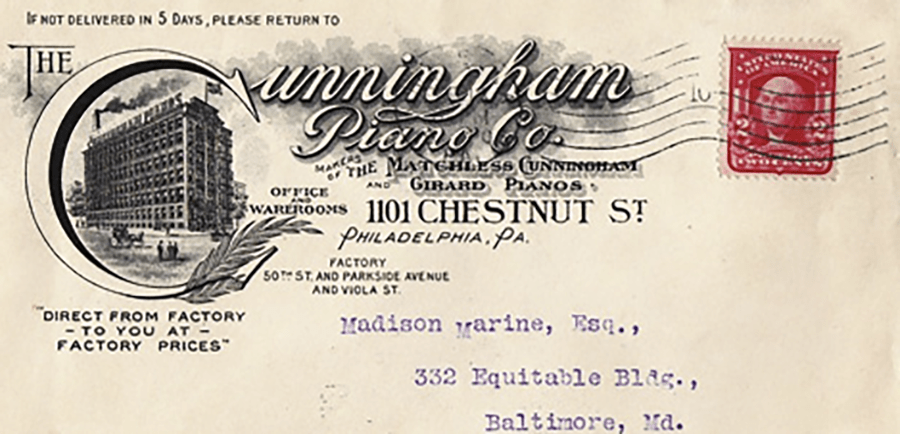
In 2007, the Cohen family sold the company to us, Tim Oliver and Rich Galassini, both musicians with long histories with the company and close associations with the Cohen family. Rich began his career at Cunningham in 1987, after graduating from Temple University with a bachelor's degree in Music Education and Vocal Performance. Tim came to Cunningham in 1997, after earning a bachelor's degree in Piano Performance from Lycoming College, in Williamsport, Pennsylvania, and a successful stint as manager of a music store. As owners, our primary goal has been to turn the piano restoration shop into a complete piano remanufacturing facility capable of upgrading or replacing every worn-out component of the pianos it restores.
Cunningham's philosophy of piano rebuilding places the highest priority on the instrument's performance while retaining as much as possible of its original scale design. This philosophy takes the modern approach of replacing all aged materials with the best available new parts that most resemble the originals. To that end, Cunningham seeks out the technicians, processes, and suppliers best equipped to achieve that goal. The rebuilding of vintage Steinway, Mason & Hamlin, and other famous American grands from the 1870s onward comprises the bulk of Cunningham's piano restoration business.
The restoration facility is divided into three major departments: Belly/Woodworking, Refinishing, and Action/Assembly. Each department has its own manager, all overseen by vice president and factory foreman Kurt Weissman. Joining Cunningham in 1990 and foreman since 2008, Weissman has been a piano rebuilder for 35 years. Raised in the piano rebuilding scene of New York City, Weissman has had a lifetime of exposure to manufacturing techniques used by Steinway & Sons and Mason & Hamlin. His pursuit of knowledge has even led him to the Bösendorfer factory in Vienna, Austria, where he acquired advanced voicing techniques. It is his concepts and tooling inventions that guide Cunningham's restoration business today.
The first area of the restoration facility a piano will encounter is the Belly/Woodworking Department, headed by Jason Andino, who joined Cunningham in 2009. Andino's résumé includes 14 years of installing soundboards and pinblocks at Steinway & Sons, rebuilding pianos for the Manhattan School of Music, and having been raised in the New York piano rebuilding shop of his father, a well-known rebuilder who worked at Steinway for 25 years. Andino places a high priority on the exact re-creation of original downbearing, sidebearing, and pinblock fit, as well as staying true to the types of spruce and maple used by the original manufacturer. Although soundboard cracks and rib separations are treated with concern, Andino regards the existence of sufficient soundboard crown as the most critical element to be considered in the question of whether or not to replace a soundboard. And in order for pianos made before WWII, when restored, to achieve the proper sustain and warmth of tone, the question of whether or not to replace the soundboard is most often answered by Andino in the affirmative.
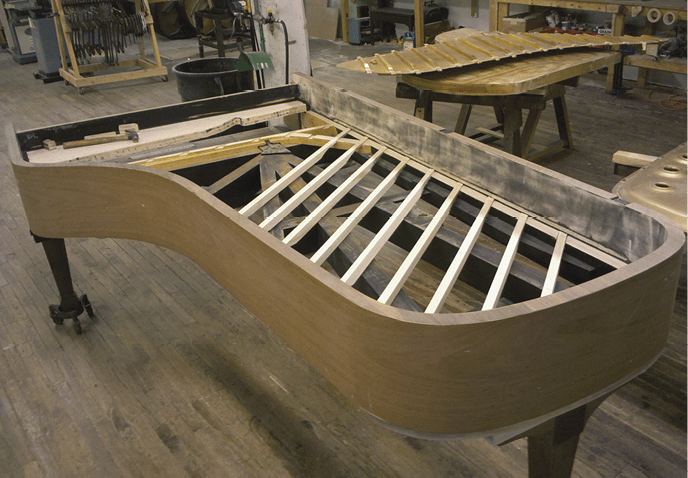
Andino and his team first do a thorough diagnosis to precisely determine the materials and processes needed to restore the instrument to its original splendor. The piano's action cavity is cleaned, and the instrument's structure and belly — rim, bridges, soundboard, and cast-iron plate — are evaluated. Measurements are taken throughout the piano, digital pictures are taken for record-keeping purposes, and materials needed for this specific instrument are ordered. The belly is disassembled, and each component's dimensions and relative placement in the piano are meticulously measured. The new pinblock is fitted to the plate and case, a step critical to the piano's tuning stability, and thus requiring great care and expertise for best long-term performance. Spruce soundboard ribs are crafted and positioned in the shelf of the inner rim, using fixed locating points to ensure that all measurements are correct. After the ribs are glued to the newly crafted tapered soundboard, the bridge positions are also precisely located, and the bridges are glued to the soundboard in the bridge press. (A tapered soundboard, which has more mass at its center, is more flexible and gives the instrument's tone better sustain.) Once the new soundboard is installed, a replica of the original decorative soundboard decal is applied, followed by a light coat of finish to protect the spruce without impeding its natural vibrations, and the piano is ready for the next department.
Lee Bauer, manager of the Refinishing Department, focuses not only on refinishing, but on cabinet restoration, antique preservation, and overall beauty. Having always gravitated toward artistic fields that require hands-on skills, Bauer sought out Cunningham years ago with the goal of learning about cabinet preservation. His desire is that the work he performs last as long as possible. The piano's cabinet is disassembled into some 20 individual pieces, and each is stripped of finish to create as clean a surface as possible for the new finish. Each part is meticulously examined with an eye to its qualities as a work of art, rather than as just a piece of furniture, and for loose veneer and damage that may have resulted from years of use. Replicas of worn-out carvings are made, and new veneers are applied where needed. A moisture-resistant polyester sealer is used as a primer to give the instrument a clean, smooth surface that will not change with time. A UV-blocking protective finish is custom-mixed to restore the instrument's original color or to meet a customer's request.
The cast-iron plate gets a separate treatment of its own, known as regilding. After the plate is stripped down to gray iron, a black self-etching primer is applied to bond to the metal. A second priming coat is used to properly hold the finish and smooth out any unevenness in the metal surface. Finally, an appropriate metallic suspension finish is used for beauty. Raised plate artwork is detailed by hand, and a clear coat of lacquer is applied for lasting protection and luster.
Last, the piano must visit the Action/Assembly department. Once the cast-iron plate is repositioned and the case parts reassembled, the first task is to restring the piano. Restringing is a process where detailed work is appreciated, especially by the technicians who will tune this piano over the next several decades. A neat and organized drilling of the pinblock, installation of the tuning pins at the proper angle, and careful coiling of the piano wire on the tuning pins will result in more predictable movement of the pins and strings while enhancing the instrument's appearance. Additionally, tuning of the duplex system will give the instrument an audible sparkle.
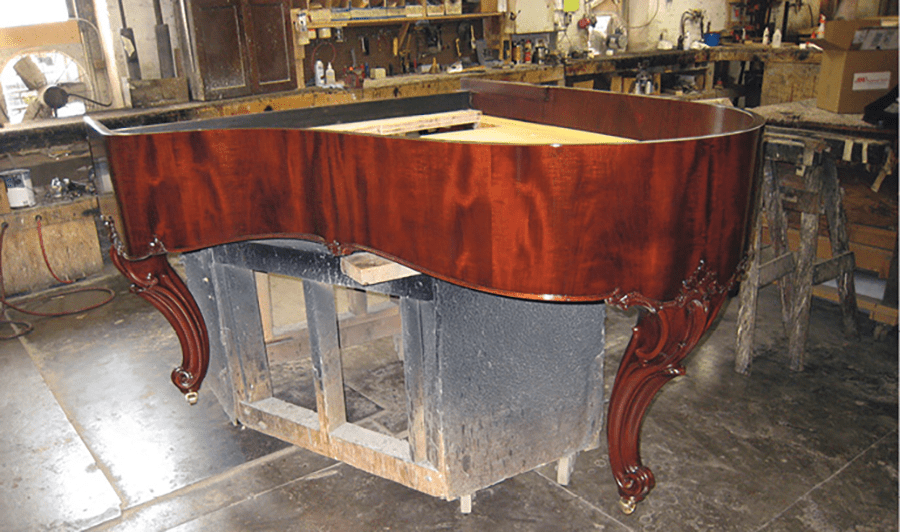
There are 5,000 moving parts in a piano action, made of wood, leather, wool felt, cloth, and buckskin, and all the degradable materials need to be replaced in order for the instrument to offer the pianist the greatest opportunity for musical expression. Curt Brown and Joseph Cossolini head up this department, bringing to their task decades of experience in restoring pianos. They inspect all work done to this point, and install and adjust all action parts. The hammers and shanks, damper felts, backchecks, key bushings, key end felts, and key frame felts are replaced, damper underlever systems are reconditioned or replaced, and the movement and timing of all action parts are coordinated through a series of hundreds of adjustments called action regulating. The evolution of the piano over the last 150 years has resulted in many different possibilities for action geometry, so parts from suppliers such as Steinway, Renner, and Wessell, Nickel & Gross are carefully chosen to authentically re-create the action geometry engineered by the original manufacturer. However, understanding these geometric relationships also allows improvements to be made when needed to lighten the action, or in other ways to create a better playing experience for the pianist.
The last step of the restoration process is one that at Cunningham we call "concertization": turning the piano into a fine, performance-ready instrument. First, the piano is played in by machine for a full day to settle the cloth and felt parts. Then, every part of the instrument is re-examined. It is fine-tuned several more times, the hammers are voiced, and the action is given additional regulating as needed. Last, the piano is given a final quality inspection in the form of extensive playing by one or more of the accomplished pianists on the Cunningham staff.
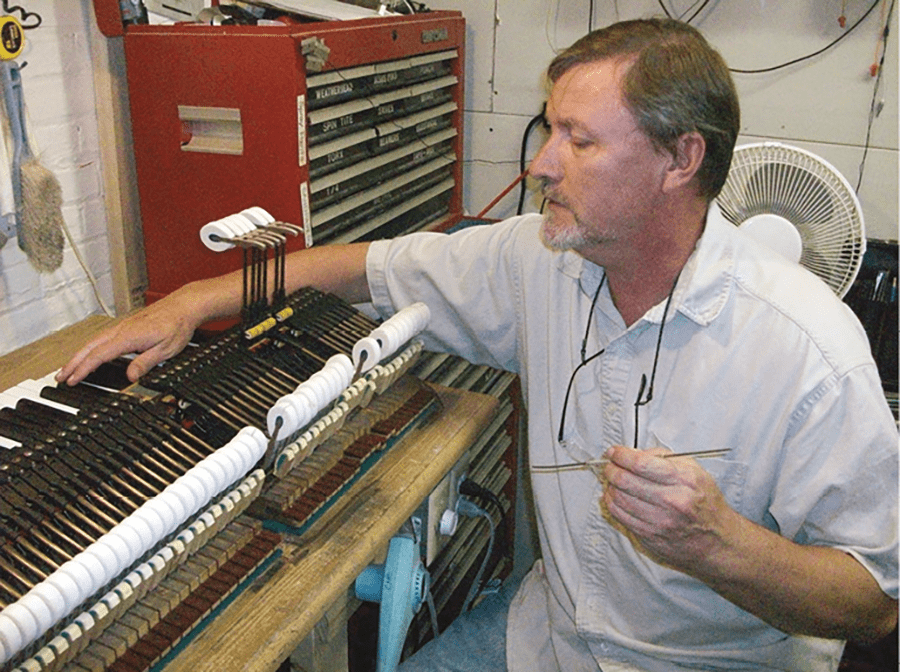
When the restoration is completed, the piano will have the tuning stability, tonal projection, feel, response, and visual beauty of a new instrument. The owner or purchaser will, in addition, have the satisfaction of knowing that the original manufacturer's intentions have been honored, that our world's natural resources have been minimally tapped into to restore rather than to create anew, and that the cost of the restored instrument is but a fraction of that of a new premium piano. Cunningham has been the source of restored premium grand pianos for several piano dealers and major universities in the United States, as well as for clients in Munich, Panama City, Beijing, Tokyo, Milan, Seoul, and Rio de Janeiro, among other international locations.
Cunningham's experience in restoring pianos has led to the creation of its own brand, the Matchless Cunningham. In development for many years, this instrument has received rave reviews from musicians affiliated with several prestigious Philadelphia-area institutions. The creation of the Matchless was made possible by the restoration shop's intimate knowledge of the world's best suppliers of piano parts. Frank Emerson, a world-respected American piano designer, developed a new scale based on the original American-made Cunningham. His commission was to create a balanced, warm tone from top to bottom, using high-quality piano parts and the efficient and capable Chinese production facility that manufactures the Hailun brand. The Matchless Cunningham is available in two smaller grand sizes for the home, two larger grand sizes for concert work, and two studio uprights. Although the Matchless was originally intended for only the Philadelphia market, Cunningham's current plan is to distribute it nationally.
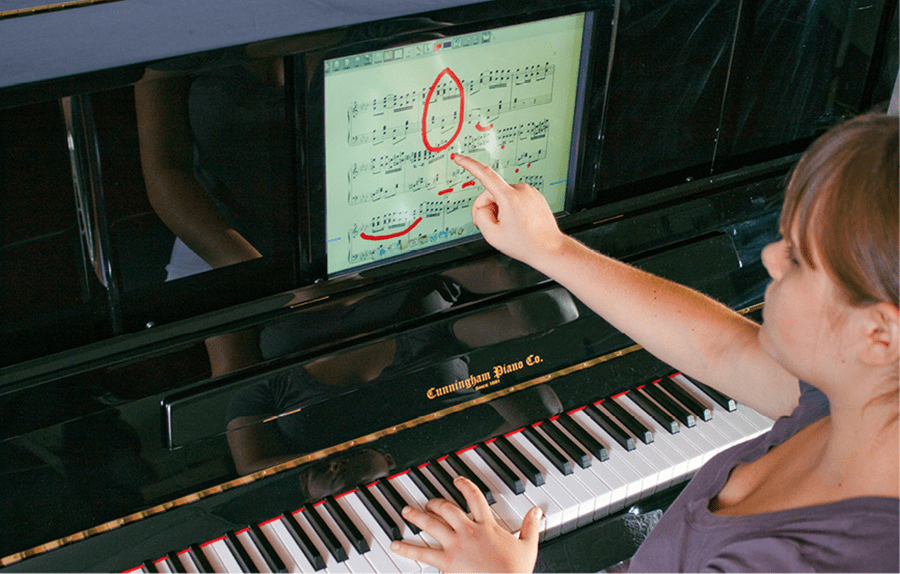
The staff at Cunningham has also developed a studio upright called the Cunningham Composer, based on the Matchless. A touchscreen computer monitor is built into the Composer's front panel, a MIDI recording strip is installed beneath the piano keys, and a Mac mini computer is mounted under the keybed. The piano keystrokes of the Composer can be instantly recorded, and the music notated on an onscreen musical staff, printed out via a computer printer, and offered to the public via the Internet before the proverbial ink is dry. With an open-architecture approach that can interface with any commercially available music-notation software, the Cunningham Composer is a versatile instrument with as many options as the computer age can offer.
Decades ago, Patrick Cunningham offered $10,000 to anyone who presented conclusive evidence that they could make a better piano than he could. Because no one ever took him up on his offer, he named his piano Matchless. It is bold concepts such as this that, even today, still echo through the halls of the Cunningham Piano Company. 